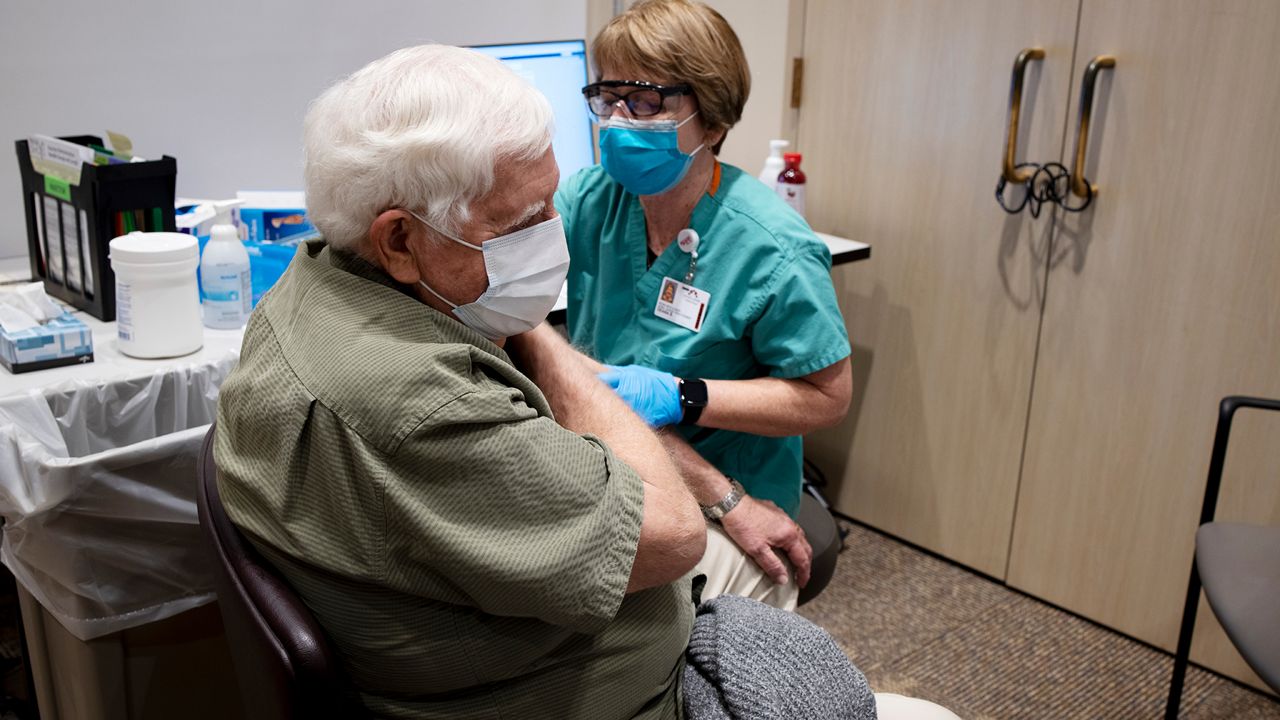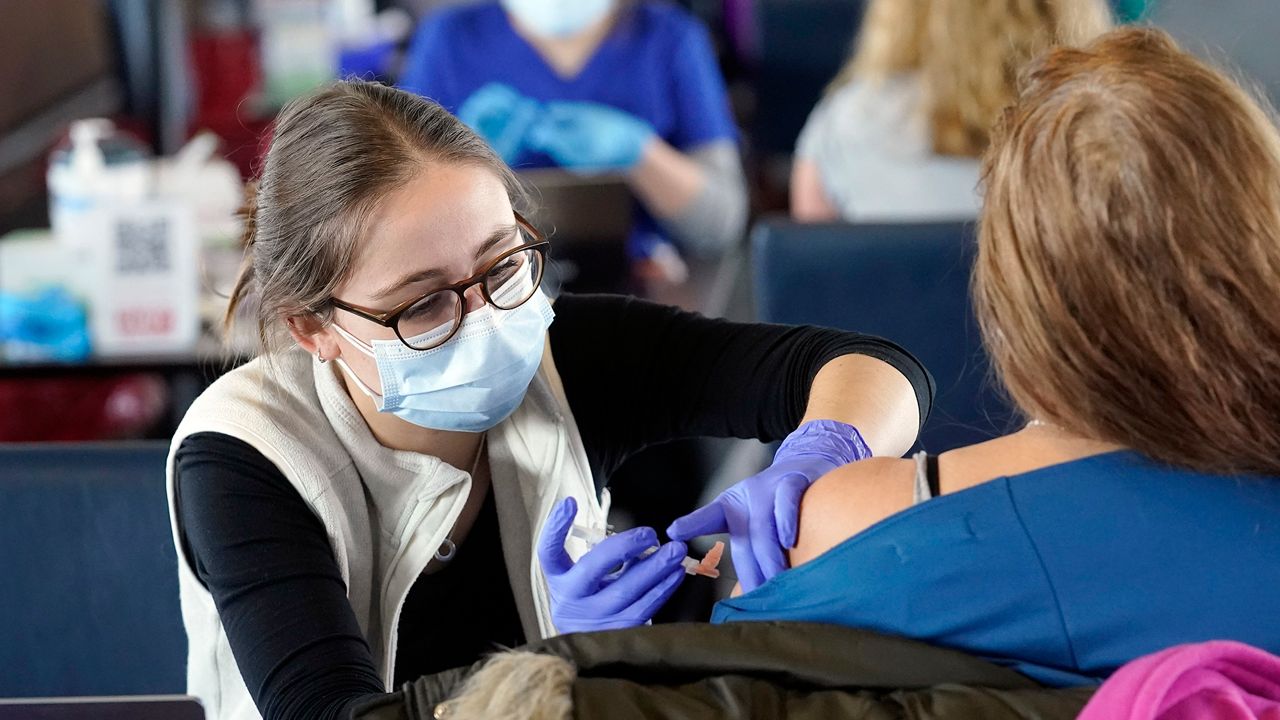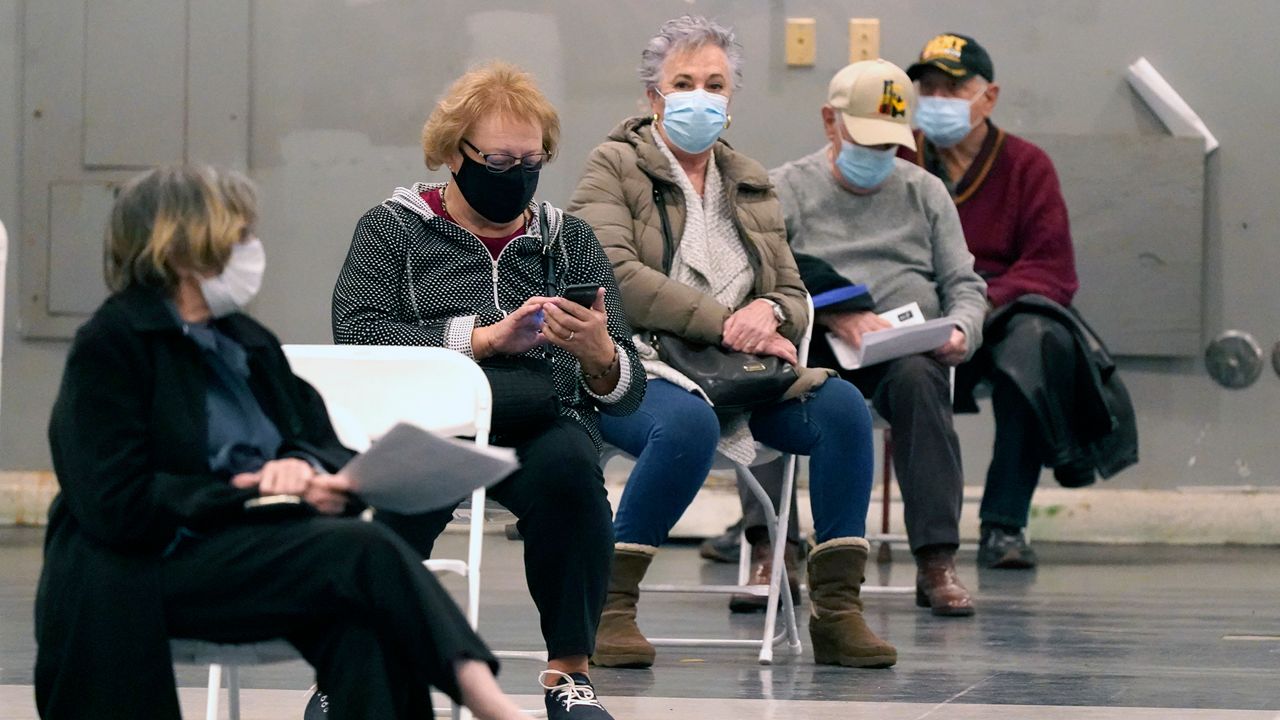COLUMBUS, Ohio — Coronavirus cases in the Midwest have fallen by 74% since states began vaccinating in the middle of December at the peak of a fall surge, an even more pronounced drop than the similar dips in other regions of the country.
Entering a new phase of the pandemic — a race between vaccines and more contagious variants — officials said the way we behave in the coming weeks will determine whether the surge is the Midwest’s last.
In the fall, as temperatures dropped across the Midwest, COVID-19 cases went in the opposite direction. A combination of factors, including mixed messaging from public officials, pandemic fatigue, and a return to school were among the causes of the spike.
The surge was exacerbated by the winter holidays. Despite officials calls for residents to stay home, they said surges in interstate travel to visit family, maskless dinners, and parties on New Year’s Eve helped sustain the months-long surge.
The Midwest was soon joined by the rest of the country, as December set a record for the most COVID-19 deaths in the U.S. It was promptly broken in January.
But as the death count climbed, good news emerged just before the holidays in the form of a COVID-19 vaccine. By the end of January, trends were moving in the right direction. Nearly two weeks into February, the drops in cases, deaths, and hospitalizations continue as the vaccinations increase.
However, as vaccine begins to offer some hope, highly-infectious variants of the virus threaten to derail the progress in the Midwest and the rest of the nation.
Officials said they are encouraged by the trends, but worry about underestimating a virus that defied expectations and flared up in the region in the fall.
As more schools reopen and states begin easing restrictions from the surge, some residents are taking any bit of normalcy they can find, while others continue to shelter, fearing a virus that is still spreading in nearly every community.
Vaccines bring hope, but equal parts frustration as many seniors are reporting extreme challenges getting in for an appointment.
“My Declaration of Independence”
In Columbus, Ohio, 81-year-old Alan Case said without the help of his son-in-law, he would not have been able to get a vaccine appointment.
The retired insurance agent said his doctor’s office didn’t have the vaccine, so he was left contending with the masses for an appointment.
Even though he was “first in line” because Ohio prioritized seniors older than 80, Case said when he called around to make an appointment he would just get stuck on hold.
“It seemed like I was always a day late and a dollar short to get on the list,” he said. “The biggest problem with me is searching for stuff on the computer. I’m just not computer savvy enough to do a lot of that.”
His daughter, who lives in Cincinnati, helped him get on a list outside of the county, and his son-in-law got him registered with Mount Carmel Health — one of the major health systems in Central Ohio — where he had not previously been for treatment as a patient.

“The hardest thing is trying to get on somebody's list, and, of course, I was in one of the priority groups,” he said. “The key for folks is to not get frustrated — try to find somebody younger who can help you get on a list.”
Case got his second shot of the Pfizer BioNTech vaccine Friday, and he is looking forward to going to church again with his wife, visiting St. George Island in Florida this summer, and making a weekend trip to drive a golf cart around Put-in-Bay, an island village in Lake Erie.
He said he will follow the guidance and wear a mask, but he hopes that can be tapered off as time goes on. With a highly effective vaccine in his system, Case said he’ll feel comfortable having friends over for a meal who he hasn’t seen in the last year, or going out to eat with them at restaurants.
“My reaction to the shot was that I just had my Declaration of Independence,” Case said.
So far, most states have relied on vaccine providers to register eligible vaccine recipients. But as residents complain of arduous processes to make appointments, states are building websites to centralize vaccine registration. Wisconsin officials said the state is working with Microsoft to develop an online tool for registration. Ohio is expected to launch a portal this week after onboarding providers on Valentine's Day.
U.S. health officials said last week the vaccine supply will pick up soon. Dr. Anthony Fauci expects weekly shipments to the states to grow through March and April. The Johnson & Johnson vaccine is expected to be available soon, said Fauci, the nation’s top infectious disease expert.
Midwest states have vaccinated between 10-13% of their residents, and 3-6% of residents have received second shots. So far, the pace of vaccination in the U.S. has failed to meet projections. Top Trump administration officials said there would be enough doses to vaccinate 50 million people by the end of January. As of Feb. 14, only 38.8 million people had been vaccinated.
Despite the slow pace, officials said vaccines are making in impact curtailing the spread of the virus.
Numbers Move in the Right Direction
The key metrics measuring the severity of the pandemic — cases, hospitalizations, and deaths — are on the decline in the Midwest
While these numbers count as progress, Wisconsin Department of Health Services Deputy Secretary Julie Willems Van Dijk told reporters last week that there is still much room for improvement.
The trends are “really good news,” she said. “On the other hand, when we were on the upslope of this curve, and we were hitting 970 cases a day, we thought we were in dire straits. So, it is all relative and, as we've said, this is still far too high a rate.”
In Ohio, each day of the past week has seen a reported case count well below the 21-day average of 3,573. In the week ending Sunday, 19,133, cases were reported in the Buckeye state, down 22% from 24,425 the reported the previosu week, which were down by a similar amount from the previous week when 31,470 cases were reported.

The 21-day trend shows a dramatic decline in cases since mid-January. On January 21, the state reported 7,271 cases and 21-day rolling average of 7,111 cases. On Feb. 14, those numbers were down to 2,733 and 3,573 respectively. Hospitalizations are also trending downward. The number of COVID-19-positive patients hospitalized in Ohio dropped below 2,000 for the first time in three months a week ago, and on Sunday hospitalizations were down to 1,657 patients.
While the peak of Ohio’s outbreak came in mid-December, Wisconsin's hit a month earlier. The state has seen a steady decline in case counts since, with a brief spike in early January. The seven-day case average now sits at 919, down from more than double that two weeks ago. The last time the seven-day average fell below 1,000 was in early September.
Wisconsin’s total number of COVID-19 hospitalizations is now under 500, a steep decline from the peak in November, when more than 2,000 people were hospitalized with the illness. The drop in deaths has been less precipitous, though they are falling, too. Wisconsin’s seven-day average in daily COVID-19 deaths now stands at 19. The last time it was that low came in mid-October.
Kentucky never saw the same peaks as Ohio and Wisconsin, and it’s not seeing quite the same decline either. The seven-day case average in the commonwealth now sits at 1,573, in a state with 77% of Wisconsin’s population and 38% of Ohio’s. It’s a decrease from the heights of early January, but it’s not quite the drop some of Kentucky’s midwestern neighbors have seen.
While Ohio’s COVID-19 cases are down 39% in the past two weeks and Wisconsin’s are down 38%, Kentucky’s are down 34%. The commonwealth has also seen a less dramatic decline in hospitalizations, with an average of 1,120 over the past week.
The least encouraging stat is Kentucky’s COVID-19 deaths, which are up 3% over the past two weeks. The current seven-day average of 33 daily deaths is not far behind the late January peak of 44.
Kentucky Gov. Andy Beshear admitted this week that his state is, “still seeing far too many deaths” from COVID-19. But he also sounded an optimistic note. “This decreased positivity rate is a really hopeful leading indicator,” he said. “We have come so far in our fight against this virus – now, we need to hang on until we reach the finish line.”
Though vaccinations in Ohio topped the 1 million mark last weekend, deaths have only marginally declined. As of Feb. 10, the last accurate update due to data reporting errors, seven-day average of COVID-19 deaths in the state was 61, down from 67 on Jan. 31, and 72 on Dec. 31.
Emerging Virus Variants Threaten Progress
Even as things seem to be looking up in the Midwest, another development is cause for concern: Mutated variants of the virus have cropped up across the region.
The highly contagious variant known as B.1.1.7, which was first identified in the United Kingdom, is the most widespread international variant in the U.S., per Centers for Disease Control and Prevention data — and it’s been discovered in most midwestern states. Wisconsin and Kentucky have reported two cases each.
“We’ve made a lot of progress, but we’re also highly vulnerable to see some of that progress undone if we take our foot of the gas, if we let the virus spread,” Wisconsin state epidemiologist Ryan Westergaard said after the state announced its second variant case. And what we’re seeing is probably “the tip of the iceberg,” he said, as the U.S. is only doing full genetic sequencing on a small percentage of samples.

Minnesota was the first U.S. state to identify a case of the P.1 variant, which first emerged in Brazil. And on Thursday, Illinois reported the first case in the region of the B.1.351 variant that emerged in South Africa. Officials at a Cleveland lab said it has detected "several of the emerging COVID-19 variants, including the U.K. variant.”
It’s normal for viruses to mutate as they spread, making small “typos” as they copy themselves over and over. But these variants have racked up a high number of genetic changes, including shifts in the spike protein — which the virus uses to bind to human cells, and which serves as the target for vaccines and other treatments.
The fact that we are seeing the same mutations show up in different strains around the world is significant, said Keith Gagnon, an associate professor at Southern Illinois University whose lab has been tracking the virus’s genome.
“The bigger implication is that this virus is starting to change and adapt to its host and its environment,” Gagnon said. “The question is: Can we move faster than the virus?”
His team has sequenced what they believe to be a “homegrown” variant of the virus, and published their findings in a preprint study in January. Gagnon said this variant, dubbed 20C-US, appears to have branched off on the genetic tree last spring, and become especially dominant in the upper midwest.
Though 20C-US started off with its own set of mutations, in some cases, the variant is now picking up the same spike protein changes we’ve seen in other strains, Gagnon adds.
“We're now entering a phase where there's going to be a very complex mixture of these variants, all competing,” he said. “That's really the take-home, is not to pit one variant against another, but to see these variants are sort of all converging on similar solutions to their problems.”
Gagnon said the “silver lining” is that the shots appear to be good enough to protect against severe disease from these variants, though there’s been some concern that mutated viruses could slip past immune defenses.
So, these variants don’t really change the precautions people should take — they just raise the stakes, said Dave O’Connor, a UW-Madison professor whose lab is sequencing virus samples in Wisconsin.
Keeping the virus’s spread slow and the vaccine rollout quick will still be key to fighting the pandemic, O’Connor said.
And maintaining a close watch on any emerging variants — ideally, ramping up genetic sequencing to a much higher level than it’s at now — is also important, he said, because the virus isn’t likely to stop changing anytime soon.
“We have to continue to be vigilant for the emergence and spread of these new variants,” O’Connor said. “The ones that we're dealing with right now are not the last ones we're going to have to deal with. It's going to be a constant battle.”



